
| Return |
|
• September 27 The dramatized story of the master swordsman Miyamoto Musashi has been on the air by NHK (Japan Broadcasting Corporation) television. I have a precise replica of his long sword (made of wood) , which Musashi used at a fight with his archrival Sasaki Kojiro. The certification for this sword (No. 148 sword) was issued by Haruyuki Matsui, the 13th master of Matsui Family. Musashi often held his sword in a similar way to a baseball batter holding his bat upright. Musashi made his long sword hurriedly to match Kojiro's long sword. If you hold it quietly in your hands with your face toward the imaginary opponent, this heavy sword will help you to picture vividly the fight at Ganryujima Island with Kojiro in the distant past. Was it fine or cloudy that fateful day? I can hear the sound of waves washing the shore of Ganryujima or is it my imagination? Around that time outside Japan, Galileo and others might have been exploring the universe with small telescopes. * Miyamoto Musashi and Sasaki Kojiro were 17th-century legendary masters of swordsmanship. They had a fateful and decisive fight on Ganryujima Island, in which Musashi killed Kojiro by his long wooden sword. |
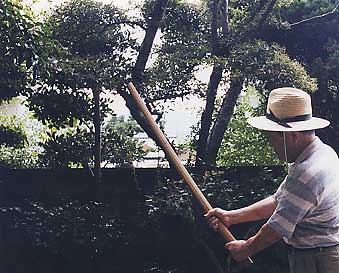 The replica of the wooden sword used by Miyamoto Musashi  The certificate issued by Matsui Family |
| • September 21 (Observatory and searching) Strong winds were blowing at the observatory with Typhoon No. 15 passing offshore to the south. However, transparency was superb and gegenschein was visible north of Cetus at midnight as well as a narrow band of the zodiacal light. I found the large glow of M31 without searching and M33 in Triangulum appeared a faint spot of light to my eyes. My eyesight is still good !? Because of poor seeing I avoided observation of faint stars by the 60cm telescope and patrolled the sky from the midnight zenith to Taurus along the ecliptic. At the same time with the 21cm Epsilon telescope I swept the sky near Leo in the east. I also visually searched carefully the sky from the "nest" of the Kreutz group to the sickle of Leo. I captured NGC 2903 (m: 9.5) at a very low altitude. All the stars in the sky were heaving heavily but with the naked eye it was a magnificent sight. Comet Okabayashi-Honda of September 1940 may have been discovered in a dark sky like this. How beautiful the starry skies above Geisei ! |
 The open cluster M35 in Gemini Telescope: ε210 September 22, 2003 10-minute exposure from 4 am  Rising Orion Telescope: ε210 10 minute exposure on September 22 |
|
• September 18 Comet Honda shone over the devastated town immediately after the war. Mr. Honda, who called himself "hoshi-tazunebito" (a star inquirer), discovered many comets, but the fact that he was a poet of stars is not well known to the general public. Mr. Kunio Kenmotsu, who had been managing Kurashiki Observatory, has recently published a compilation of the notes, poems, and haiku written by Mr. Honda between his observing sessions. It is a modest publication not for sale and given only to a limited number of people. Readers will recognize an unknown side of Mr. Honda, who loved the stars all his life, and will be touched by his endless passion for observation. Mr. Kenmotsu, the compiler of the book, saw Comet Honda discovered in November 1947 immediately after the war, using Kurashiki Observatory's 31-cm Calver mirror. As the comet speeded south after the discovery, Mr. Honda was the only Northern Hemisphere person that observed this comet. While Mr. Kenmotsu was visiting Kurashiki Observatory on his school excursion, Mr. Honda showed him the comet. He was such a lucky person. In those days I was a star-loving first-year junior high school student myself. Comet Honda shining in a cool autumn sky! Mr. Minoru Honda, our great predecessor, gave countless young people dispirited in the defeat of war a dream and hope for life, but he is no longer with us. |
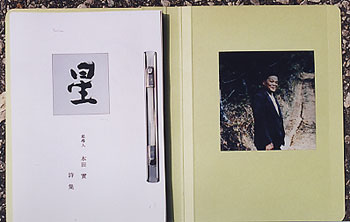 A collection of Mr. Honda's poems (The photo was taken when he visited Geisei Observatory in 1982.)  |
| • September 11 Mr. S's submarine, which had left Kagoshima Port, sailed into a typhoon in the East China Sea. Fitting her name "Rough Seas", the submarine continued to take a southward course riding out storms. Was he able to find pirates' treasures left on the bottom of the southern ocean? Mr. S lived his 70-year-long life with endless dreams and eccentricity. His ship now sits on the beautiful Katsurahama looking as if she were eternally dreaming. It is the harvest moon tonight. It was on the night of the harvest moon 55 years ago that I met Mr. S. It was at a "harvest moon viewing" party held by OAA Kochi Branch. Comet Honda, the first comet discovered by Mr. Honda since the end of the war, was shining in the sky that night. |
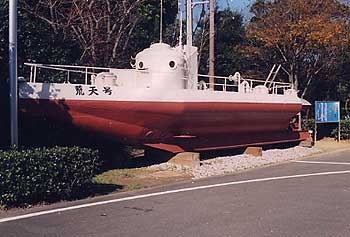 The submarine Kouten-go on display at Katsurahama Beach |
| • September 8 There was a public viewing night today. About 50 visitors came to the learning center which could hold only 40. It was a very warm evening with a lot of clouds about, but when it became dark the 13-day-old moon was shining and brightening Mars was seen a short distance east from the moon. Many of the visitors were families. They were all enthusiastic and serious about learning. With a wayward thought that, if all these children came to love the stars, Japan would become a wonderful, peaceful place to live, I helped all the visitors individually at the eyepiece, from 3- or 4-year-olds to junior high school students as well as adults. Mars showed the south polar cap quite well at 300x, which had become smaller recently. Around the time the moon set, Canis Major appeared in the southeastern sky. Draw a line between Alpha and Beta and extend it about 5 times. You will find the "nest" of the sungrazing Kreutz group. I have a feeling that a great comet from the family can appear this year. After all, It has been 38 years since the discovery of Comet Ikeya-Seki... |
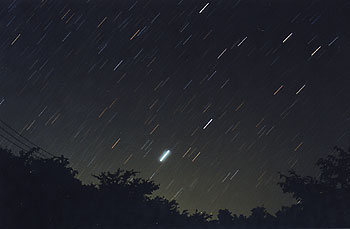 Rising Canis Major Nikon F3 50mm 5-minute exposure |
| • September 5 From the rooftop above the 3rd floor of my residence we can clear see the Ryoma Memorial Museum nearing completion. It is a two-story timber construction and on the reverse side of roof tiles were inscribed messages for Ryoma from citizens. I joined them to write "Minor Planet 2835 Ryoma." Very few people in Kochi, Ryoma's birthplace, know about the star bearing Ryoma's name. Kochi Prefecture puts in a lot of effort in sports, politics, and gambling, but when it comes to science they show little interest. Needless to say, there is no scientific facilities in Kochi City. |
 Ryoma Memorial Museum nearing completion |
| • September 4 Scorching summer days are continuing. I searched the eastern sky before dawn this morning, the first time in many days. There were very few clusters and nebulae drifting across the eyepiece field. I searched the sky consulting the star charts in my memory built up over many years of observation. The dancing white light of Sirius rose at 4 am already. The nest of the Kreutz sungrazer family will come into view before long. I can hardly wait for the autumn, the season for comet searching, to arrive! |
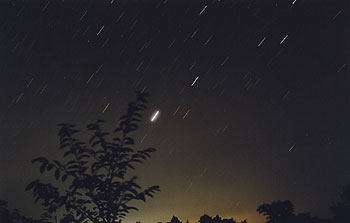 Rising Sirius At 4 am September 4 |
| • September 1 About 50 people gathered together for the Mars observing night. The weather was good and both Mars and the Milky Way were fine sights. Inside the dome the temperature rose to nearly 40 degrees C and I felt dehydrated. After the visitors left, I worked hard to observe many comets and patrol the sky for new objects with the 60cm telescope. I might have looked like an exhausted artillery soldier handling a big gun. Incidentally, my father was an artillerist. It became cloudy before the dawn, but hugely bright Sirius rose above the horizon. I was mesmerized by brilliant winter constellations. How I missed Orion ! |
Copyright (C) 2003 Tsutomu Seki.